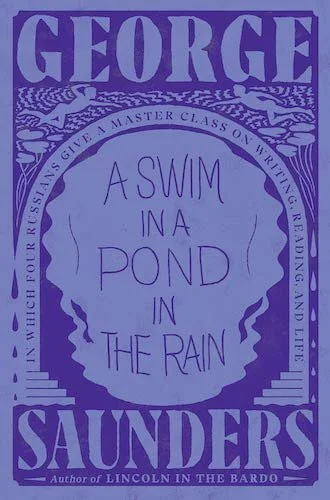A Swim in a Pond in the Rain
In my review of George Saunders’ essay collection The Braindead Megaphone, I noted the “humane curiosity” that characterizes his writing: “He is genuinely interested in the world we share, and the people we share it with, and wants us to share that interest. I find his writing persuasive in this regard, and infectious.”
Saunders isn’t known first for his essays, of course, but for his short stories. He’s a contemporary master of the form, possibly the best in the biz. And while the art of fiction is different from that of an essay (persuasion happens differently, for one thing), I’ve always appreciated the way that same humane curiosity permeates his short stories as well.
And now he’s showing us how his writing habits—and large parts of his imagination—have taken form. A Swim in a Pond in the Rain: In Which Four Russians Give a Master Class on Writing, Reading, and Life (Random House) is based on a course Saunders has been teaching his students at Syracuse for decades. He selects a handful of his favorite short stories written by Russians in the nineteenth century and dissects them, page by page. But don’t worry, these dissections don’t have the feel of lab experiments. Cold and sterile this book is not.
When Gogol has a barber discover a detached human nose in a loaf of bread, or Tolstoy pulls us along on a miserable, misbegotten carriage ride in a blizzard, Saunders has the audacity to posit some clues as to what the authors might be up to in telling us all this.
By studying and teaching their work over the years, Saunders came to the realization that these Russians “seemed to regard fiction not as something decorative but as a vital moral-ethical tool. They changed you when you read them, made the world seem to be telling a different, more interesting story, a story in which you might play a meaningful part, and in which you had responsibilities.”
Fiction isn’t, or doesn’t have to be, escape. Good fiction does work on us. Stories can soften hearts and stimulate minds. (That’s why some people are afraid of them.)
But none of this happens by accident. So when we “get lost” in a story or are moved to tears by a character’s situation or find that we remember a phrase or a sentence years later, that’s a story doing what it was designed to do. And in these essays, Saunders names a few of the ways these great writers manage to do it.
This is a book that demands concentration. One of the stories reprinted here is 50 pages long, presumably intended to be read in one sitting, ideally followed in short order by Saunders’ own exploration of the story’s structure and themes.
But the dedicated reader will be rewarded. Saunders brings these dead Russians to life in a way that leaves me marveling at their craft, honed as it was over long, hard years. I’ll never be a Gogol or a Tolstoy or a Chekhov, and I don’t need to be. But maybe, just maybe, I can learn something from them—and from our winsome teacher who reminds us, seriously (for the most part), that “we’re reading to see what we can steal.”
